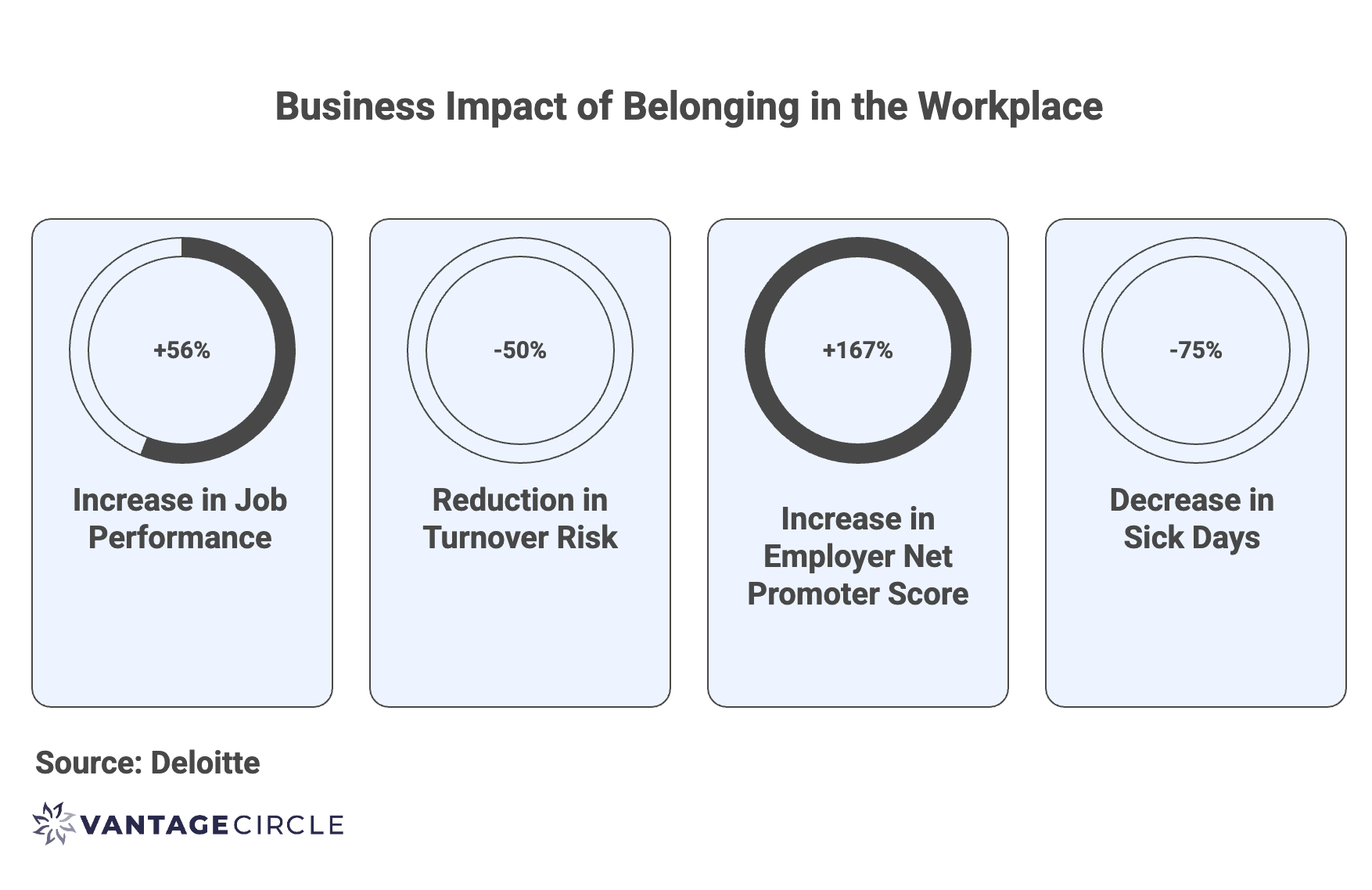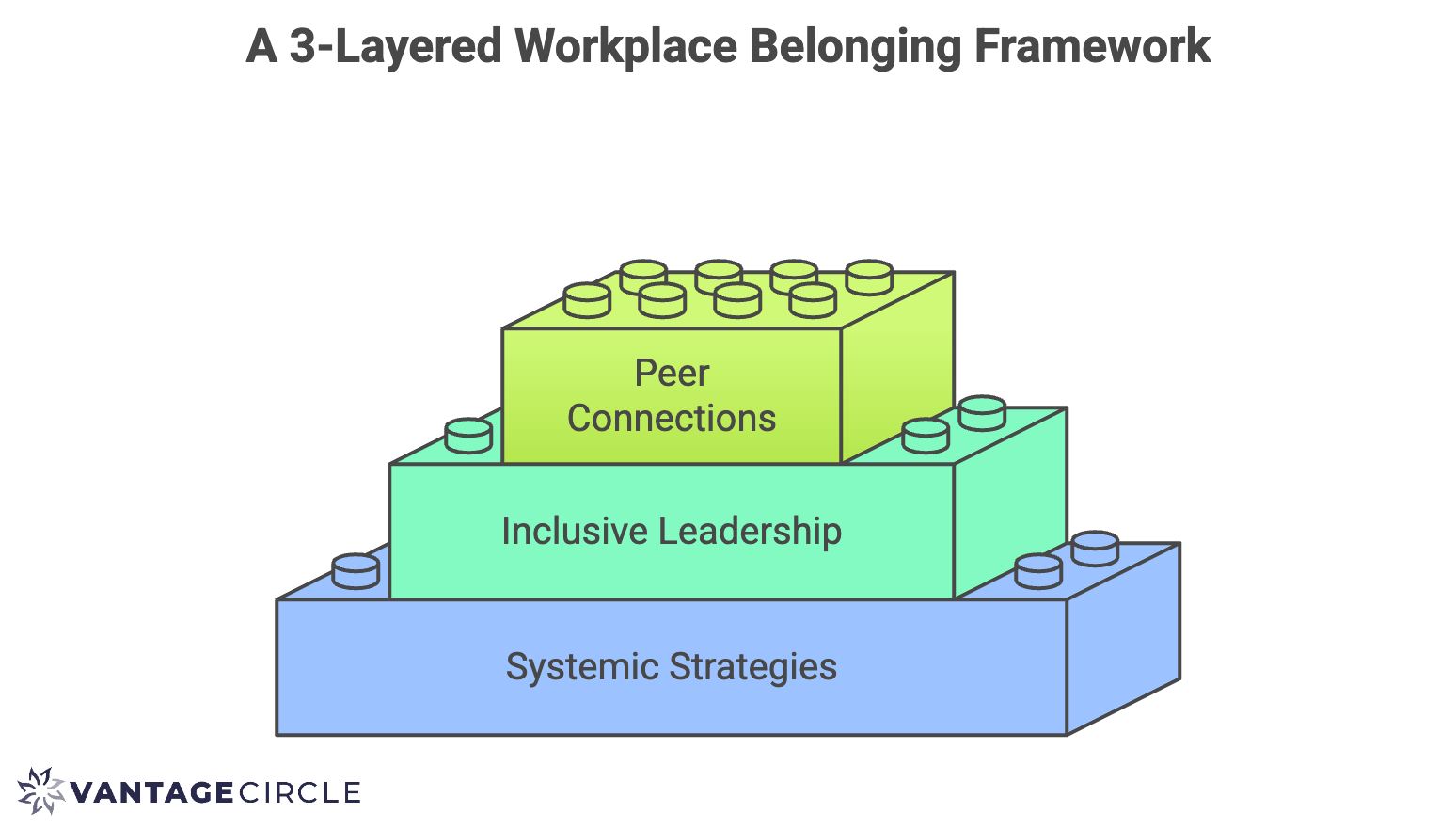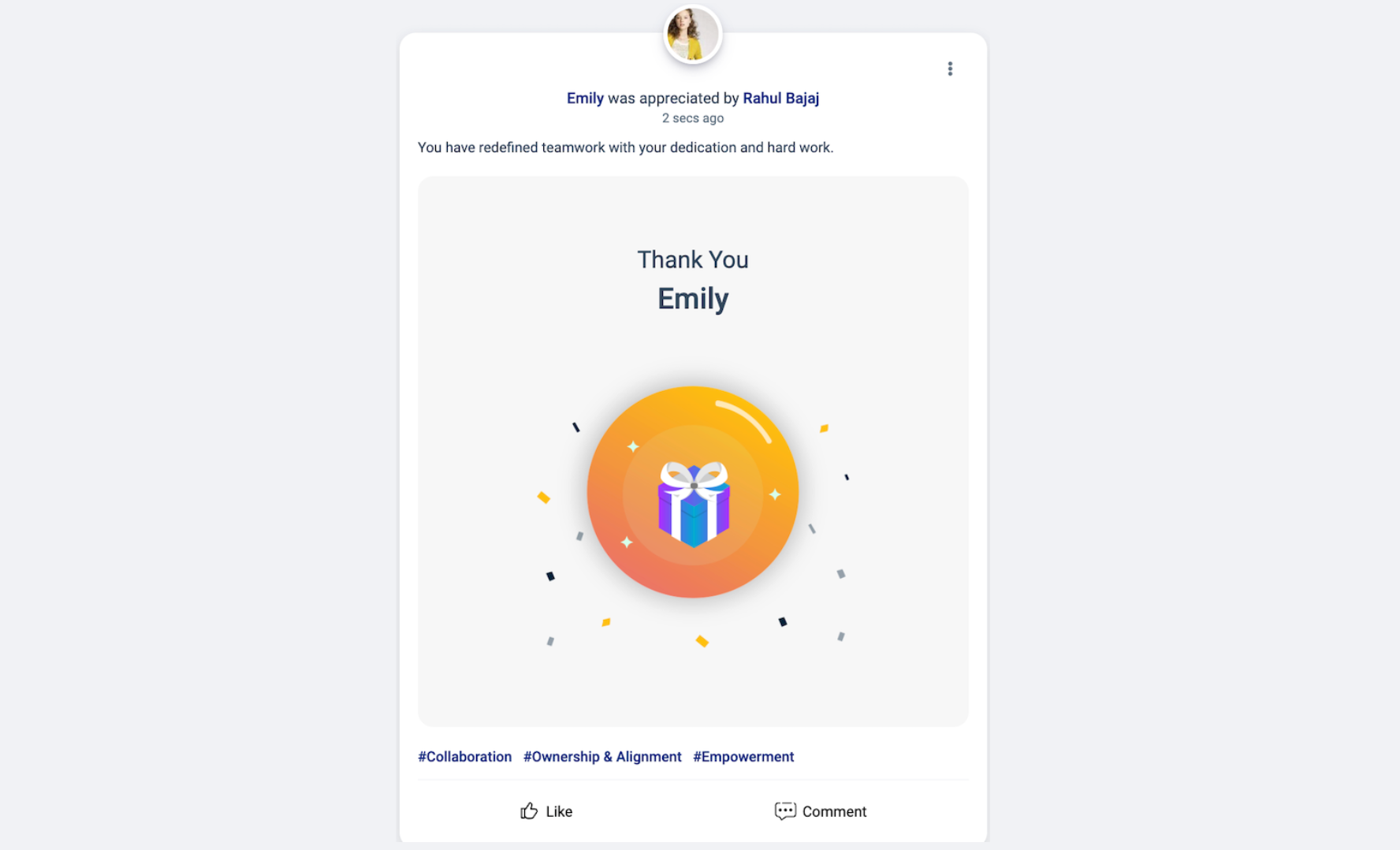How to Build a Sense of Belonging in the Workplace

A Global Employee Recognition and Wellness Platform
Sarah had a brilliant idea during the quarterly planning meeting. She knew it could streamline their product development process by weeks. But she stayed silent. Why?
Because the last three times she spoke up, her suggestions were either ignored or credited to someone else later. Sarah didn't feel like she belonged at the decision-making table.
This scenario plays out in conference rooms across the globe every day. Talented employees withhold their best ideas because they don't feel they belong in that workplace.
Workplace belonging is about creating an environment, a company culture where every employee feels seen, valued, and psychologically safe to bring their authentic self to work. Research from Great Place to Work shows that only 64% of employees at average workplaces feel they can be themselves. At the best companies, that number jumps to 88%. The gap represents millions of workers who show up but leave their best selves at home.
Creating belonging requires systematic effort across three critical layers:
- Organizational systems,
- Leadership behaviors, and
- Peer connections.
This guide will show you how to build that culture and ensure employees like Sarah never have to choose between belonging and contributing their best work.
Key Insights
- Concept of sense of beloging in the workplace
- Importance of belonging from Business perspective and from Employee perspective
- A 3-layered framework for creating workplace belonging
- How to measure belonging in your organization
- Common challenges of beloging in the workplace and how to overcome them
What is a Sense of Belonging at Work
Belonging at work goes deeper than fitting in or getting along with colleagues. It's the feeling that you can show up authentically while being valued for your unique contributions.
Think about the difference between conforming and belonging. When employees conform, they adapt themselves to match the existing culture. They might succeed, but they leave parts of themselves behind. When employees belong, they bring their whole selves forward and find that their differences are welcomed.
Research from Coqual identifies four core elements that define workplace belonging:
-
Seen - You're recognized and respected for your contributions. Your work matters, and others acknowledge it.
-
Connected - You have genuine relationships with colleagues across levels. These connections feel authentic, not forced.
-
Supported - You receive what you need to succeed and grow. This includes resources, guidance, and understanding during challenges.
-
Proud - You feel aligned with your organization's values and purpose. The company's mission resonates with your personal values.
When all four elements align, employees experience true belonging. They stop wondering if they fit in and start focusing on how they can contribute. This shift from self-protection to contribution is where the business value emerges.
Belonging also means freedom from what researchers call "belonging uncertainty." This is the mental burden of constantly questioning whether you're accepted or valued. Employees experiencing belonging uncertainty spend cognitive energy on self-doubt instead of innovation and problem-solving.
The distinction matters for leaders. You can't simply tell employees they belong. You have to create conditions where belonging naturally develops through consistent actions and inclusive systems.
Why is Belonging Important?
The business case for belonging is compelling from multiple angles. Let's examine why it matters for both organizations and employees.
From the Business Perspective

Source: Deloitte
Companies with strong belonging cultures outperform their competitors across key metrics. Here's what the data reveals:
Innovation and Engagement: Employees who feel they make a difference are 64% more likely to engage in high levels of innovation. When people feel psychologically safe, they share ideas freely instead of keeping them to themselves.
Retention and Performance: Organizations where employees feel they belong see significantly lower turnover rates. A Harvard Business Review study demonstrates that employees who receive regular positive recognition go above and beyond in their jobs more often.
Decision-Making Quality: Diverse teams with high belonging make better decisions. When everyone feels heard, teams access a wider range of perspectives and avoid groupthink.
Financial Results: Companies on Fortune's 100 Best Companies to Work For list, where belonging scores are consistently higher, deliver better stock performance and profitability compared to market averages.
From the Employee Perspective
For individual employees, belonging affects both performance and wellbeing:
Cognitive Freedom: When employees don't worry about fitting in, they can focus their mental energy on their actual work. They stop second-guessing themselves and start contributing more boldly.
Career Growth: Employees with high belonging scores report feeling less stalled in their careers. They're more likely to seek challenging assignments and advocate for themselves.
Mental Health: Belonging reduces workplace stress and prevents burnout. Employees feel supported during difficult periods and are more resilient when facing challenges.
Authentic Expression: When people can bring their whole selves to work, they're more creative and engaged. They don't waste energy maintaining a workplace persona that differs from who they really are.
The convergence is clear. What's good for employee wellbeing drives better business results. Belonging creates a virtuous cycle where engaged employees deliver stronger performance, which strengthens the culture and attracts more talent.
A 3-Layered Framework for Creating Workplace Belonging
Creating belonging isn't a single initiative or program. It requires coordinated effort across three interconnected layers of your organization. Each layer builds on the others to create a comprehensive culture of inclusion.

Layer 1: Systemic & Organizational Strategies form the foundation. These are the policies, processes, and structural elements that either support or undermine belonging.
Layer 2: Inclusive Leadership brings the systems to life. Managers and leaders translate organizational intentions into daily experiences for their teams.
Layer 3: Peer-to-Peer Connection builds the social fabric where belonging thrives. Employees need genuine relationships with colleagues to feel truly connected to their workplace community.
Think of these layers like a building. Strong organizational systems provide the foundation and framework. Inclusive leadership acts as the electrical and plumbing systems that make everything function. Peer connections are the interior design that makes the space feel like home.
When all three layers work together, belonging becomes embedded in how work gets done. Let's explore each layer in detail, starting with the systemic foundation that supports everything else.
Layer 1: Systemic & Organizational Strategies
Your organizational systems send powerful signals about who belongs and who doesn't. These systems operate whether you pay attention to them or not. The question is whether they're working for or against belonging.
1.1. Implement Fair and Transparent Processes
Fairness forms the bedrock of belonging. Start with your most visible processes like hiring, promotion, and performance evaluation by making criteria explicit, documenting decision rationale, and conducting regular audits to identify bias patterns.
1.2. Audit Your HR Policies for Inclusivity
Your HR policies shape daily experiences and may not reflect your current workforce needs. Review leave policies, dress codes, communication norms, and benefits to ensure they don't inadvertently exclude certain groups while accommodating diverse life circumstances.
1.3. Champion and Fund Employee Resource Groups (ERGs)
ERGs need genuine organizational support beyond permission to exist. Provide dedicated budgets, connect them to business objectives, ensure meaningful executive sponsorship, and avoid burdening members with solving all diversity challenges.
1.4. Redesign Your Onboarding for Connection
Employees form lasting impressions about inclusion within their first few weeks. Create belonging-centered onboarding that starts before day one, assigns trained connection partners, includes structured feedback opportunities, and showcases diverse success stories.
Layer 2: The Critical Role of Inclusive Leadership
While organizational systems provide the foundation, leaders bring belonging to life through their daily actions and decisions. Managers have the most direct impact on whether employees feel seen, supported, and valued in their immediate work environment.
2.1. How Managers Can Build Psychological Safety
Psychological safety is the foundation of belonging where employees feel safe to take risks, make mistakes, and speak up without fear of negative consequences. Leaders create this safety by normalizing failure, sharing their own uncertainties, and responding supportively when team members admit mistakes or ask for help.
2.2. The Power of Individualized Recognition and Empathy
Generic praise feels hollow, but personalized recognition shows employees that their unique contributions are truly seen and valued. According to Gallup, employees who get consistent recognition are 65% less likely to seek new job opportunities.

Source: Vantage Recognition
Effective leaders learn what motivates each team member individually and recognize achievements in ways that resonate with each person's preferences and values.
2.3. Running Inclusive Meetings: A Checklist
Meetings reveal who truly belongs in decision-making and whose voices are heard or ignored. Create inclusive meetings by actively soliciting input from quieter members, rotating speaking opportunities, sharing agendas in advance, and ensuring follow-up actions reflect diverse perspectives shared during discussions.
2.4. Giving and Receiving Feedback to Foster Trust
Trust builds when feedback flows both ways and focuses on growth rather than judgment. Leaders should provide specific, actionable feedback regularly while also asking for feedback on their own leadership style and creating safe channels for upward feedback.
Layer 3: Cultivating Peer-to-Peer Connection
The strongest belonging cultures emerge when employees genuinely connect with and support each other, independent of formal leadership structures. This peer-level connection creates the social fabric that makes work feel like a community rather than just a place to earn a paycheck.
3.1. Facilitating Authentic Social Rituals (Not Forced Fun)
Meaningful connection happens through regular, low-pressure opportunities for colleagues to interact as whole people. Focus on creating consistent rituals like team lunches, coffee chats, or brief personal check-ins rather than elaborate team-building events that can feel artificial or exclusive.
3.2. Creating Peer-to-Peer Recognition Programs
When recognition comes from colleagues, it carries special weight because peers understand the day-to-day challenges and contributions most intimately.

Source: Vantage Recognition
Establish systems where employees can easily recognize each other's work, and ensure these programs are accessible to all employees regardless of their role or seniority level.
3.3. Encouraging Active Allyship and Mentorship
Belonging thrives when employees actively support colleagues who may face additional challenges or barriers. Create formal mentorship programs and train employees on how to be effective allies by amplifying others' voices, sharing opportunities, and advocating for colleagues across different identity groups.
How to Measure Belonging in Your Organization
Most leaders have a gut feeling about how their people are doing and often, those instincts are pretty accurate. But belonging lives in the nuances that intuition can miss, which is why measurement becomes your best ally in creating the culture you actually want. You can't improve what you don't measure. Belonging requires both quantitative data to track trends and qualitative insights to understand the human experience behind the numbers.
Quantitative Metrics: Surveys and HR Data
Start with employee engagement surveys that include specific questions about the four elements of belonging: feeling seen, connected, supported, and proud. Track these scores over time and segment them by demographic groups, departments, and tenure to identify patterns and disparities.
Your existing HR data also reveals belonging patterns when analyzed thoughtfully. Look at retention rates, promotion timelines, participation in voluntary programs, and internal mobility patterns across different employee groups to spot where belonging gaps might exist.
Qualitative Insights: Stay Interviews and Focus Groups
Numbers tell you what is happening, but stories tell you why it's happening and how to fix it. Conduct regular "stay interviews" with high-performing employees to understand what keeps them engaged and belonging, rather than waiting for exit interviews to learn what went wrong.
Focus groups with employees from different backgrounds and experience levels provide deeper insights into belonging challenges and opportunities. Ask open-ended questions about daily experiences, decision-making processes, and what would make them feel more valued and included.
Recommended Resource: Stay Interview Survey Template
Common Challenges and How to Overcome Them
Even well-intentioned belonging initiatives can face obstacles. Understanding these common challenges helps leaders navigate them proactively rather than reactively.
1. Creating Belonging in a Remote or Hybrid Workplace
Physical distance makes casual connections and cultural transmission more difficult. Schedule regular virtual coffee chats, and ensure remote employees have equal access to informal conversations. Create digital spaces for non-work connection and recognition.
Remote work can also amplify existing belonging challenges for employees who already felt marginalized in physical offices. Be particularly attentive to ensuring remote employees aren't overlooked for opportunities, informal mentoring, or spontaneous collaboration that builds relationships.
2. Avoiding the "Belonging Tax" on Underrepresented Employees
Organizations often burden employees from underrepresented groups with additional emotional labor, such as -
- educating colleagues,
- serving on diversity committees, or
- being the "voice" for their entire demographic.
This belonging tax can lead to burnout and resentment, making these employees feel less rather than more included.
Distribute diversity and inclusion work fairly across all employees, compensate those who take on additional DEI responsibilities, and avoid making any individual responsible for representing or educating others about their entire identity group.
Related Read: What is Diversity, Equity, Inclusion, and Belonging (DEIB) in the Workplace?
3. The Difference Between Belonging and Simply "Fitting In"
Many organizations mistake conformity for belonging, encouraging employees to adapt themselves to the existing culture rather than bringing their authentic selves forward. True belonging means the culture adapts to include different perspectives and working styles, not the other way around.
Watch for signs that employees are code-switching or hiding parts of themselves to succeed, and actively celebrate differences in communication styles, problem-solving approaches, and cultural perspectives rather than expecting everyone to work the same way.
Summing It Up
Creating workplace belonging is one of the highest-impact investments you can make as a leader. Organizations with strong belonging cultures see better retention, increased innovation, and superior financial performance. More importantly, they unlock the full potential of every employee.
The three-layered framework provides a systematic approach to building belonging. Start with organizational systems that ensure fairness and transparency. Layer on inclusive leadership behaviors that create psychological safety. Top it off with peer connections that make work feel like a community.
You don't need to implement everything at once. Choose one strategy from each layer and build momentum through consistent action. Measure your progress through both data and stories. Most importantly, remember that belonging isn't a program you launch but a culture you nurture daily.
Remember Sarah from our opening story? In organizations with strong belonging cultures, Sarah speaks up in those meetings. Her ideas are heard, valued, and often implemented. That's the measurable difference between workplaces where people simply show up and those where they truly belong.
The choice is yours. Will your organization be a place where talented employees like Sarah stay silent, or will it be one where every voice contributes to your collective success?
Frequently Asked Questions (FAQ)
Q. What is the most important factor for workplace belonging?
Psychological safety is the foundation that enables all other belonging elements to flourish. When employees feel safe to express ideas, admit mistakes, and ask questions without fear of negative consequences, they can begin to connect authentically with colleagues and contribute their best work.
Q. What are some quick examples of belonging at work?
Belonging shows up in small daily moments: a manager who remembers your weekend plans and asks about them Monday morning, colleagues who pause meetings when someone's connection drops to ensure they can rejoin, or team members who actively seek your input on decisions that affect your work. These micro-experiences accumulate to create an overall sense of being valued and included.
Q. How does Diversity, Equity, and Inclusion (DEI) relate to belonging?
DEI creates the conditions for belonging, but belonging is the emotional outcome when DEI efforts succeed. Diversity brings different people into an organization, equity ensures they have fair opportunities to succeed, inclusion means their voices are heard in decision-making, and belonging is the feeling that they can be authentic while being valued for their unique contributions.
Q. Can you have too much belonging in a team?
Healthy belonging doesn't mean avoiding all conflict or challenge, but rather creating an environment where diverse perspectives can be shared and debated constructively. Teams with strong belonging actually handle conflict better because members trust each other's intentions and feel safe expressing disagreement, leading to better decision-making and innovation rather than groupthink.
















